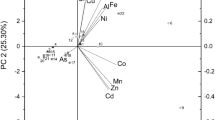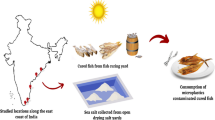Abstract
The micronutrients (vitamins and minerals) are required in small amounts but are essential for health, development, and growth. Micronutrient deficiencies, which affect over two billion people around the globe, are the leading cause of many ailments including mental retardation, preventable blindness, and death during childbirth. Fish is an important dietary source of micronutrients and plays important role in human nutrition. In the present investigation, micronutrient composition of 35 food fishes (includes both finfishes and shellfishes) was investigated from varying aquatic habitats. Macrominerals (Na, K, Ca, Mg) and trace elements (Fe, Cu, Zn, Mn, Se) were determined by either atomic absorption spectroscopy (AAS) or inductively coupled plasma mass spectrometry (ICP-MS)/atomic emission spectrometry (ICP-AES). Phosphorus content was determined either spectrophotometrically or by ICP-AES. Fat-soluble vitamins (A, D, E, K) were analyzed by high-performance liquid chromatography (HPLC). The analysis showed that, in general, the marine fishes were rich in sodium and potassium; small indigenous fishes (SIFs) in calcium, iron, and manganese; coldwater fishes in selenium; and the brackishwater fishes in phosphorous. The marine fishes Sardinella longiceps and Epinephelus spp. and the SIFs were rich in all fat-soluble vitamins. All these recommendations were made according to the potential contribution (daily value %) of the species to the recommended daily allowance (RDA). Information on the micronutrients generated would enhance the utility of fish in both community and clinical nutrition.

Similar content being viewed by others
References
WHO (2015a) Micronutrients http://www.who.int/nutrition/topics/micronutrients/en/. Accessed 28 November 2015
Global Report Summary (2009) Investigating in the future: a united call to action on vitamin and mineral deficiencies http://www.unitedcalltoaction.org/documents/Investing_in_the_future.pdf. Accessed 28 November 2015
Micronutrient Initiative (2015). http://micronutrient.org/about-mi/. Accessed 28 November 2015
National Aquaculture Sector Overview. India (2014) National Aquaculture Sector Overview Fact Sheets. Text by Ayyappan, S. In: FAO Fisheries and Aquaculture Department. Rome. http://www.fao.org/fishery/countrysector/naso_india/en. Accessed 16 March 2016
Mohanty BP, Paria P, Das D, Ganguly S, Mitra P, Verma A, et al. (2012a) Nutrient profile of giant river-catfish Sperata seenghala (Sykes). Natl Acad Sci Lett 35(3):151–161
Mohanty BP, Paria P, Mahanty A, Behera BK, Mathew S, Sankar TV, et al. (2012b) Fatty acid profile of Indian shad Tenualosa ilisha and its dietary significance. Natl Acad Sci Lett 35(4):263–269
Soetan KO, Olaiya CO, Oyewole OE (2010) The importance of mineral elements for human, domestic animals and plants: a review. Afr J Food Sci 4(5):200–222
Erkan N, Ozden O (2007) Proximate composition and mineral contents in aqua cultured sea bass (Dicentrarchus labrax), sea bream (Sparus aurata) analyzed by ICP-MS. Food Chem 102:721–725
Liu RH (2003) Health benefits of fruit and vegetables are from additive and synergistic combinations of phytochemicals. Am J Clin Nutr 78(suppl):517S–520S
Spiro A, Buttriss JL (2014) Vitamin D: an overview of vitamin D status and intake in Europe. Nutr Bull 39(4):322–350
Mohanty BP, Mahanty A, Ganguly S, Sankar TV, Chakraborty K, Rangasamy A, et al. (2014) Amino acid composition of 27 food fishes and their significance in clinical nutrition. J Amino Acids. doi:10.1155/2014/269797
Roos N, Islam MM, Thilsted SH (2003) Small indigenous fish species in Bangladesh: contribution to vitamin A, calcium and iron intakes. J Nutr 133:4021S–4026S
Mohanty BP (2010) Fish as health food. In: Ayyappan S, Moza U, Gopalakrishnan A, Meenakumari B, Jena JK, Pandey AK (eds) Handbook of fisheries and aquaculture, 2nd edn. ICAR New Delhi, DKMA, pp. 843–861
Gokoglu N, Yerlikaya P, Cengiz E (2004) Effect of cooking methods on the proximate composition and mineral content of rainbow trout (Oncorhynchus mykiss). Food Chem 84:19–22
Fiske CH, Subbarow Y (1925) The colorimetric determination of phosphorous. J Biol Chem 66:375–400
Djedjibegovic J, Larssen T, Skrbo A, Marjanovic A, Sober M (2012) Contents of cadmium, copper, mercury and lead in fish from the Neretva river (Bosnia and Herzegovina) determined by inductively coupled plasma mass spectrometry (ICP-MS). Food Chem 131:469–476
Cindric IJ, Krizman I, Zeiner M, Kampic S, Medunic G, Stingeder G (2012) ICP-AES determination of minor and major elements in apples after microwave assisted digestion. Food Chem 135:2675–2680
Folch J, Lees M, Sloane-Stanley GH (1957) A simple method for the isolation and purification of total lipids from animal tissues. J Biol Chem 226:497–509
Chatzimichalakis PM, Samanidou VF, Papadoyannis JN (2004) Development of validated liquid chromatography method for the simultaneous determination of eight fat-soluble vitamins in biological fluids after solid-phase extraction. J Chromatogr B 805:289–296
Indian Council of Medical Research (2009) Nutrient requirements and recommended dietary allowances for Indians. ICMR, New Delhi, p. 334. http://icmr.nic.in/final/rda-2010.pdf. Accessed on 16 March 2016
Tulchinsky TH (2000) Micronutrient deficiency conditions. Global Health Issues Public Health Rev 32(1):243–255
Takatsu A, Kuroiwa T, Uchiumi A (1999) Arsenic accumulation in organs of the fresh water fish Tribolodon hakonensis. J Trace Elements Med Biol 13:176–179
Tahvonen R, Aro T, Nurmi J, Kallio H (2000) Mineral content in Baltic herring and Baltic herring products. J Food Comp Anal 13:893–903
Lidwin-Kaźmierkiewicz M, Pokorska K, Protasowicki M, Rajkowska M, Wechterowicz Z (2009) Content of selected essential and toxic metals in meat of freshwater fish from west Pomerania, Poland. Polish J Food Nutr Sci 59(3):219–224
FAO/INFOODS (2013) FAO/INFOODS Food Composition Database for Biodiversity Version 2.1-BioFoodComp2.1 Food and Agricultural Organization of the United Nations. World Health Organization, Geneva, Switzerland
Mahanty A, Ganguly S, Verma A, Paria P, Mitra P, et al. (2013) Nutrient profile of small indigenous fish Puntius sophore: proximate composition, amino acid, fatty acid and micronutrient profiles. Natl Acad Sci Lett 37:39–44
Larsen T, Thilsted SH, Kongsbak K, Hansen M (2000) Whole small fish as a rich calcium source. Br J Nutr 83:191–196
FAO/WHO 2001 Expert consultation on human vitamin and mineral requirements. Bangkok, Thailand
WHO (2015b) Micronutrient deficiencies: iron deficiency anaemia http://www.who.int/nutrition/topics/ida/en/. Accessed on 28 November 2015
Celik U, Oehlenschlaager J (2004) Determination of zinc and copper in fish samples collected from Northeast Atlantic by DPSAV. Food Chem 87:343–347
Bogard JR, Thilsted SH, Marks GC, Wahab MA, Hossain MAR, Jakobsen J, Stangoulis J (2015) Nutrient composition of important fish species in Bangladesh and potential contribution to recommended nutrient intakes. J Food Compost Anal 42:120–133
Rayman MP (2000) The importance of selenium to human health. Lancet 356:233–241
Zeba AN, Sorgho H, Rouamba N, Zongo I, Rouamba J, Guiguemdé RT, Hamer DH, Mokhtar N, Ouedraogo JB (2008) Major reduction of malaria morbidity with combined vitamin a and zinc supplementation in young children in Burkina Faso: a randomized double blind trial. Nutr J 7:7
WHO (2015c) Global prevalence of vitamin A deficiency in populations at risk 1995–2005: WHO global database on vitamin A deficiency.http://apps.who.int/iris/bitstream/10665/44110/1/9789241598019_eng.pdf. Accessed 28 November 2015
Ross N, Wahab MA, Chamnan C, Thilsted SH (2007) The role of fish in food based strategies to combat vitamin A and mineral deficiencies in developing countries. J Nutr 137(4):1106–1109
Dias MG, Sánchez MV, Bártolo H, Oliveira L (2003) Vitamin content of fish and fish products consumed in Portugal. Electron J Environ Agric Food Chem 2(4):510–513
Stancheva M, Dobreva D, Merdzhanova A, Galunska B (2010) Vitamin content and fatty acids composition of rainbow trout (Oncorhynchus mykiss). Plovdiv University, Paisii, Hilendarski – Bulgaria, Scientific papers 37(5):117–124
Ozyurt G, Polat A, Loker GB (2009) Vitamin and mineral content of pike perch (Sander lucioperca), common carp (Cyprinus carpio), and European catfish (Silurus glanis). Turk J Vet Anim Sci 33(4):351–356
Holick MF (2004) Sunlight and vitamin D for bone health and prevention of autoimmune diseases, cancers, and cardiovascular disease. Am J Clin Nutr 80(suppl 6):1678–1688
Holick MF (2007) Vitamin D deficiency. New Eng J Med 357:266–281
Ganji V, Milanoe C, Cody MM, McCarty F, Wang Y (2010) Serum vitamin D concentrations are related to depression in young adult US population: the Third National Health and Nutrition Examination Survey. Int Arc Med 3:29
Schneider C (2005) Chemistry and biology of vitamin E. Mol Nutr Food Res 49:7–30
Boscoboinik D, Szewczyk A, Hensey C, Azzi A (1991) Inhibition of cell proliferation by α-tocopherol. Role of protein kinase C. J Biol Chem 266:6188–6194
Prasad KN, Edwards-Prasad J (1982) Effects of tocopherol (vitamin E) acid succinate on morphological alterations and growth inhibition in melanoma cells in culture. Cancer Res 42:550–555
Tait SF, Hurrell RF (1996) Bioavailability of minerals and trace elements. Nutr Res Rev 9:295–324
Sankar TV, Anandan R, Mathew S, Asha KK, Lakshmanan PT, Varkey J, Aneesh PA, Mohanty BP (2013) Chemical composition and nutritional value of anchovy (Stolephorus commersonii) caught from Kerala coast, India. Eur J Exp Biol 3(1):85–89
Acknowledgments
This work was supported by Indian Council of Agricultural Research, Fisheries Science Division under Outreach Activity on Nutrient Profiling and Evaluation of fish as a Dietary Component (ICAR-FSD-OA#3). The authors are thankful to the Directors of the participating research institutes under the Fisheries Science Division, ICAR viz. CIFRI, Barrackpore; CIFA, Bhubaneswar; CIBA, Chennai; CIFT, Cochin; CMFRI, Cochin; CIFE, Mumbai; and DCFR, Bhimtal, for facilities and support. The authors are thankful to Dr. S. Ayyappan, former Secretary, DARE and DG, ICAR; Dr. B. Meenakumari, former DDG (Fisheries Science); Dr. S. D Singh, former ADG (Inland Fisheries) and Dr. Madan Mohan, former ADG (Marine Fisheries) for the encouragement and support.
Author information
Authors and Affiliations
Corresponding author
Ethics declarations
Conflict of Interest
The authors declare that they have no conflict of interest.
Electronic Supplementary Material
Table S1
(DOCX 15 kb)
Rights and permissions
About this article
Cite this article
Mohanty, B.P., Sankar, T.V., Ganguly, S. et al. Micronutrient Composition of 35 Food Fishes from India and Their Significance in Human Nutrition. Biol Trace Elem Res 174, 448–458 (2016). https://doi.org/10.1007/s12011-016-0714-3
Received:
Accepted:
Published:
Issue Date:
DOI: https://doi.org/10.1007/s12011-016-0714-3




